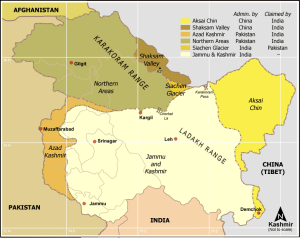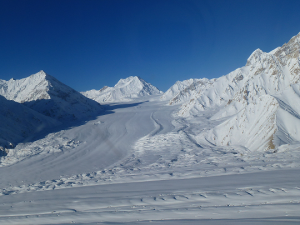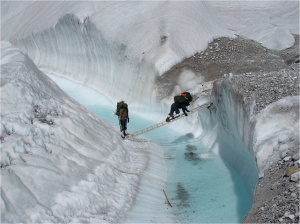Yesterday, 15th August 2014 was the 68th Independence Day of Bharatiya Gan-Rajya or the Republic of India. The subcontinent, the country & its culture is referred to as India or Indian because the civilization was developed on the banks of the mighty river Sindhu, or Indus. Every foreigner who came into India via land crossed the Indus river to get to India. So the river came to define the land, its culture and its people.
Sometimes we wonder whether the focus on Indus does grave injustice to the real definition of Bhaarat. Because the land, its culture and people are defined by something enormously more majestic, something that towers over the world today as India once towered above all other nations. We mean the mighty Himaalaya (short “a”), the Holy Land, the Devat-Atma or Atman (loosely Soul) of the Gods.
Today’s Indian subcontinent was formed when a mobile landmass moved relentlessly to the north from the ocean and collided with the Eurasian plate. That collision pushed up the earth’s plates and created the majestic grandeur we call the Himaalaya, the Aalaya of Hima (short “a”), literally the enormous abode of snow. This, according to MIT, happened more recently, about 40 million years ago & not 50 million,than originally estimated. Amazingly, the Indian plate is still pushing into Asia and the Himaalaya is still rising by about 5 mm every year.
Nothing defines Bhaarat & its people as this Holy majestic range that spans the northern boundary of the entire subcontinent. To this day, hundreds of thousands of Indians make the trek to visit this God’s home on earth braving conditions that test their devotion. The Himaalaya has protected India for millenia but modern Indians forgot to protect Himaalaya. Today, large portions of this great Holy land are under the control of other countries who have tried to link up at the top of this range to look down on India, militarily & strategically.
Thirty years ago, the Indian Army in a bold, aggressive, & pre-emptive action took back a key part of their motherland. For the past 30 years, India has maintained what the Indian Army conquered in 1984. This is the story of the Indian Army’s Operation Meghdoot, the conquest of Siachen, the enormous glacier that looks over the Karakorum pass, the link between Chinese-occupied Indian territory & NonPakistan-occupied Indian territory.

This story is told is a spectacularly splendid book named Beyond NJ 1842 – The Siachen Saga, written by Nitin Gokhale, a soldier’s son and a journalist. It is a superbly written book that tells the human tale of soldiers, commanders, helicopter pilots, doctors and administrative managers who have accomplished the unthinkable. And the book is decorated with incredible photographs which will blow you away.
We cannot think of a better way to celebrate India’s Independence Day than to relive the tale of Operation Meghdoot, the operation that put India back on the top of an important section of the Himaalayan range.
1. Why is Siachen important?
Lt. Gen Parnaik, Northern Army Commander explained to Nitin Gokhale:
- “the Siachen glacier is bounded on the west by the Saltoro Range (now under Indian command) which is a very high range, and to the east by the Karakoram range and the Nubra River. So, per se, the Siachen glacier is a sort of an iced river which flows in between them. The Saltoro range actually provides domination of the entire area… There is strategic implication of the Saltoro Range, and the implication is you have the Pakistanis sitting in the northern areas; … Now out of the other areas that they have occupied, they have illegally ceded the Shakksgam Valley to the Chinese. Shaksgam Valley lies to the north of the glacier. And if Saltoro range was held by the Ppakistanis), it practically enables them to bridge the Aksai Chin and northern areas gap, which is with China, and also exercise complete control over the Karakoram pass. … By holding these areas, we would effectively deny approaches to Kargil and Leh. … Don’t forget, Kargil happened because of Siachen...”
Or as Brig. Vijay Channa, the Siachen sector commander in 1984, put it more simply:
- “Siachen ensures that Pakistan and China don’t link up on top of our head, but also makes sure that Pakistan alone does not create problems for us in the Nubra Valley. You have forestalled all that. Look at Siachen, at Karakoram Pass and look at DBO… As it is Pakistan has given Shagksham Valley to China. Why do you allow the two adversaries to encircle you?“
2. Operation Meghdoot
- “No one had fought on the glacier at attitudes in excess of 18,000 feet; No one in the world had a clue how to fight a war on the glacier. So everything that we did had to be beyond the conventional. Everything that we did had to be innovative” – Brig. Channa
Gokhale explains in human terms the amount of planning that went into launching of Operation Meghdoot. Then came the actual climb to the glacier in a blizzard and then success:
- “Amidst the blizzard however, the platton led by Capt Sanjay Kulkarni planned the first Indian flag on Bilafond La on 13 April 1984.
What does Bilafond La (pass) look like?
(Bilafond La – sentry posted at the very edge – pg 84 ) (A lonely post vs vast expanse of the glacier – pg 81)
The only regret Brig. Channa has is:
- “My only regret is that they only told me to hold the crest line. They didn’t permit me to go down (towards the Pakistani areas). One should have and closed the chapter once and for all. If we had gone down to Gyari, gone and held that area, you didn’t need to occupy the glacier at all because all routes are blocked by you.”
3. Mastering the Mountains
Taking control of Siachen is one thing. Holding it for 30 years by building a supply chain to support troops living & guarding the glacier is another. Climbing mountains for adventure is one thing & living there is yet another.
- “on the glacier itself, there are no natural resources. Not even drinking water. Only ice, mud and rock are strewn all over. Every small item, from toothpaste to a tablet of medicine has to be brought in from the outside”
- “But most forget that mountaineering teams rarely number more than 50 at a time, and the climbers do not have to stay put on the glacier for any prolonged period and fight the enemy, as the Indian Army has been doing at altitudes in excess of 18,000 feet for the past three decades.”
(mastering the mountains – pg 119) (Chintan Post how do you get there – pg 100)
4. Air Warriors
Without the amazing achievements of India’s helicopter pilots, the Indian Army could not have maintained its presence on Siachen for the past 30 years. As Gokhale writes:
- “In the 1990s, the record for highest mountain rescue in the world was from Mount Everest at 19,500 feet; Indian helicopter pilots land at 20,000 feet four times a day, every day. … “lucky few, who get posted to Ladakh, are inarguably among the best helicopter pilots in the world“
Landing on the glacier is very very different than landing in any other terrain:
- “There are areas in the Glacier where the pilots fly with a prayer on their lips. The crevasses are so deep and wide that they could swallow an entire helicopter in the event of a forced landing. – pilots have to brave temperatures as low as minus 60 degrees celsius at times. The landings then – as now – on the match box size helipads are precise.”
(helicopter swallowed by a crevasse – pg 130) (Landing on a ‘pillared@ helipad)
Just walking on the glacier is tough because crevasses can open up under you without notice. Training is essential for survival because “individually no one can survive the glacier. it is team work that matters“
(crossing the crevasse safely is a coordinated operation – pg 174)
5. Medicine Men – Siachen Saviors
Simply put, “the human body is not designed to reside and function at such altitudes”. The Indian Army could not man these posts on the glacier without the dedication & innovation of the Doctors of India’s military. As Gokhale quotes one such doctor:
- “At 17,000 feet, ans sub-zero temperature, the vast emptiness of the glacier, the sky as our roof and the threat of fresh enemy fire that was the place where I treated the injured”
Because “nothing that is learnt in Medical School applies here“, research is required and done:
- “a team of doctors were … tasked with studying venous thrombosis (clotting of the blood in veins) at high altitudes. … the study entailed repeat examinations and tests on hundreds of soldiers at every stage, starting from the plains to extreme altitudes and back over a duration of more than two years. No such study had been done anywhere in the world till then“
The results are evident:
- “high altitude pulmonary edema (HAPE), which once afflicted on an average 15 out of 100 soldiers who served on Siachen, now affects less than one soldier per 100 soldiers stationed there today”
This is true of the entire Siachen venture according to Gokhale:
- “Much has changed in the intervening three decades. Leh has become a thriving town, the road to base camp via Khardung La is all weather; the comfort levels on the glacier and the base camp have improved beyond imagination, and the Indian Army has mastered the craft of glacial development to an extent that regiments now pro-actively seek postings for their units on Siachen“
6. Jai Jawan
Lal Bahadur Shatri, the 2nd Prime Minister of Independent India, shrugged off colonial shackles and used the time-honored “offense is the best defense” maxim in 1965. To defend against a surprise attack by NonPakistan in Kashmir, Prime Minister Shastri ordered the Indian Army to strike at the heartland of NonPakistan. He coined the term “Jai Jawan, Jai Kisan” to thank the soldiers & farmers of India who work hard selflessly for their country.
Nitin Gokhale obviously shares his sentiments. His dedication speaks volume about his passion:
To
The Indian Soldier
Who gives so much and
Asks for nothing but dignity and a
little understanding from his countrymen
Send your feedback to [email protected] Or @MacroViewpoints on Twitter









Words are not enough to describe the shraddha of the jawaans for Bharat maata …. our youngsters should be drilled these contemporary stories of veerataa & and courage again & again…
Thanks for the write up….
Excellent article…Makes us proud
A motivating one.